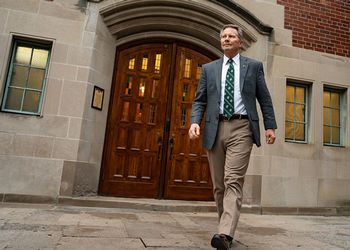Feature: Making it Greener on this Side of the Fence

Does your favorite golf course have excellent grass on the tees, fairways and greens? Does the grass in your local park or football stadium seem more hardy and resistant to wear than in the past?
If so, you might owe thanks to the MSU Libraries.
Yes, MSU Libraries is the world’s single most important repository for knowledge about turfgrass. It may be one of the best kept secrets around.
The story of how this happened is worth telling, if only to show how much care and effort is normally invested in excellence. It begins with the United States Golf Association (USGA), the governing body for golf in the U.S. Most people are probably aware that the USGA, along with the Royal and Ancient Golf Club of St. Andrews, Scotland, oversees the rules of golf. Most are probably aware also that the USGA conducts many golf competitions, including the U.S. Open and the U.S. Amateur competitions for both men and women.
But what few people know is that the USGA also works aggressively to support turfgrass research. It promotes work that leads to improved strains of grasses—such as ones requiring less water or fertilization, are more disease and heat resistant or can thrive better in shade. It also tests the best practices for turfgrass management. Many of these USGA-supported research initiatives have been conducted by MSU turfgrass faculty.
The USGA turfgrass effort ultimately leads not only to better fairways in golf courses, but also better lawns, parks, Olympic stadium fields and just about anything that uses or requires grass.
The Green Section
The USGA arm that handles the funding and oversight of the research program is known as the Green Section. In the mid-1970s, Green Section staff, as well as members of their Advisory Committee, began to notice a disturbing trend—requests kept pouring in for research that had already been undertaken. It was clear that turfgrass researchers were unaware of the results of projects already completed.
“Researchers normally identify and review previous studies on a given topic before undertaking any research,” explains Cliff Haka, director of MSU Libraries. “You would look up published results, typically in scholarly journals or research reports. The problem was that there was no index to the literature of turfgrass.”
As a librarian, Haka well understands the critical importance of indexing research. One key role played by libraries anywhere is to provide various types of indexes—such as the generic Readers Guide to Periodic Literature, or the more focused Agriculture Index, or current online tools such as PubMed or Web of Science.
An Index is Born
So why was there no such index for turfgrass? Mainly because there was no commercially sustainable market, explains Haka. Indexes are labor-intensive and expensive to produce, thereby requiring a substantial number of purchasers if the product is to prove economically viable. Around 1980 only a limited number of universities were conducting serious turfgrass research.
“An index publisher counts on selling hundreds and possibly thousands of subscriptions,” notes Haka. “There was an extremely limited market for an index of turfgrass research literature.”
The USGA realized, however, that no science can progress effectively without an appropriate index. So in the 1960s, USGA officials began to discuss this idea with Richard Chapin, then director of the MSU Libraries.
Why MSU? The development of an index requires access to the literature itself, and at that time the MSU Libraries held the most comprehensive collection of turfgrass literature in existence. So an arrangement was made for the USGA Green Section to support the development of a turfgrass index with the expectation that subscriptions would cover operating costs within a limited number of years. The transition to a subscription based model, however, did not quite materialize, validating the reluctance of commercial publishers to pursue such an endeavor.
The TGIF
Regardless of the looming financial prospects, in 1982, the Turfgrass Information Center (TIC) was established as a unit within the MSU Libraries and given the charge to produce an online index of turfgrass literature. The online index came to be known as the Turfgrass Information File, or TGIF. The indexing commenced and before long a substantial body of literature was represented within TGIF.
“Unfortunately, getting to the data remotely was no easy matter, as widespread access to the “World Wide Web” was still a decade away,” notes Peter Cookingham, director of the TIC since 1985. “It was a slow and frustrating process. Subscribers would need to contact the TIC staff, request that a search be conducted, after which the results would be mailed or faxed to the requestor.”
While concerns about access grew, it was clear that an impressive and unique database was being assembled, prompting the USGA Green Section to continue providing at least partial support for the operation, as subscriptions had not grown to cover annual costs.
Funding Sustainability
In 1997, Haka, then newly-appointed as director of libraries, tried to find a sustainable solution to the financial gap. His annual cost of operating TIC was around $200,000, while subscriptions were bringing in only around $50,000 per year.
Haka proposed to the USGA to fund an endowment, so that yearly income would cover the operating costs. He anticipated that with the advent and growth of the web, many data access issues could be eliminated. The USGA Green Section was loath to see the project abandoned, so eventually it pledged $1 million to the endowment. The fund stands at $3.5 million today and produces enough income to take care of most of the operating costs.
“What was interesting is how quickly support for this endowment grew once it was established,” recounts Haka. “Our staff came into contact with a wide variety of golf-related organizations.”
One example is the Golf Course Superintendents Association of America (GCSAA), an organization for those who manage the turf at golf courses. They loved the TGIF, but wished that it could also provide actual access to the literature that was indexed. This was not much of a problem for turfgrass researchers, the audience for whom the USGA Green Section had originally envisioned as being served by TGIF, as most turfgrass researchers reside at universities where a research library provides access to the actual materials. No such option existed for a golf superintendent at a golf course. This led practitioner groups, such as GCSAA, to suggest that TGIF add the full-text of indexed materials.
“In retrospect it is clear that had TGIF not headed in this direction, it would now be largely irrelevant, as contemporary users expect to have one or two-click access to desired resources,” says Haka.
MSU embarked on improving the TGIF in a big way. Early full-text efforts included the scanning and loading of all USGA turfgrass-related materials, followed by the monumental task of assembling and scanning the complete back file of Golf Course Management, the publication of GCSAA. This project alone processed more than 85,000 pages. In total, more than 270,000 pages of full-text are now available, with more pages being scanned on a daily basis, says Cookingham.
Practically speaking, this implies that for more than half of the 200,000 items indexed within TGIF, a user can move directly from the search results to the full-text of the item. In 2011, nearly 1.4 million searches of the TGIF database were conducted, while more than 5.6 million items were downloaded for use.
Becoming World-Class
“The TGIF is the single most valuable resource we have world wide,” says Trey Rogers, professor of turfgrass management in MSU’s Dept. of Crop and Soil Sciences. “I make sure our students get exposed to the TGIF from the time they come in until they leave.”
Just as clear as its success has been its need for additional funds to cover the costs associated with the scanning projects, which have been absorbed by the digital services unit within the MSU Libraries.
“We have an obligation to store and maintain these massive digital files for future generations, which is non-trivial,” says Haka. “We need to expand the endowment so that these obligations can be successfully engaged moving forward.”
Haka notes that supporting the research and providing access to practical information for practitioners constitute the classic land-grant mission.
“In my opinion, with all the subscribers in Australia, Canada, Europe and the United Kingdom, the Turfgrass Information File is achieving world-grant status,” concludes Haka.



